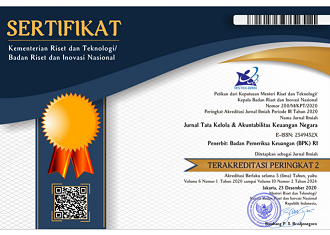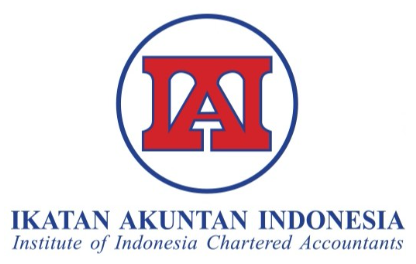MENGUKUR KESUKSESAN SISTEM AKUNTANSI INSTANSI BASIS AKRUAL (SAIBA) MENGGUNAKAN MODEL DeLONE & McLEAN
DOI:
https://doi.org/10.28986/jtaken.v2i2.62Keywords:
SAIBA, updated D&M IS Success Model, accrual basis, government accounting, institution accounting systemAbstract
This study aims to determine the user's perception of the Accrual Basis Institution Accounting System (SAIBA) in the ministry/agency in the first year of implementation of the accrual-based government's financial statements. Updated D & M IS Success Model is used to assess the success of SAIBA as a mandatory system in Indonesian Government Accounting. Respondents are operators of Institution Accounting System (SAI) in the ministries/agencies, who are joining the Workshop on Preparation and Study of Financial Statements at Pusdiklat Anggaran dan Perbendaharaan Bogor in November 2015 and selected using a purposive sampling method. The Primary data were obtained through questionnaires that were collected from 204 respondents, which were then analyzed using structural equation modeling. This study found that SAIBA can be categorized as successful information for each dimension of success in the Updated D&M IS Success Model. Respondents assessed the system quality, the information quality and service quality of SAIBA tend to be good. However, respondents indicated the use of SAIBA has no significant effect on user satisfaction, in contrast to the other constructs relationships, the system quality, the information quality, and the service quality of SAIBA with net benefit and it's reciprocal proved to be a significant impact.
References
Belcher L. W. & Watson H. J. (1993). Assessing the value of Conoco's EIS. MIS Quarterly, 17(3), 239-254.
Bernard R. & Satir A. (1993). User satisfaction with Eiss-meeting the needs of another side. Journal of Computer Information System, 43(2), 93-102.
Bradley RV, Pridmore JL and Byrd TA (2006) Information systems success in the context of different corporate culture types: An empirical investigation. Journal of Management Information System, 23(2),267-294.
Caldeira, M. M., & Ward J. M. (2002). Understanding the successful adoption and use of IS/IT in SME's: An explanation from Portuguese manufacturing industries. Information Systems Journal, 12(2),121-152.
Chiu, C. M., Chiu C. S., & Chang, H. C. (2007). Examining the integrated influence of fairness and quality on learner's satisfaction and web-based learning continuance intention. Information Systems Journal, 17(3),271-287.
Coombs, D., Doherty, N. F. & Loan C. J. (2001) The importance of user ownership and positive user attitudes in the successful adoption of community information system. Journal of End User Computing 13 (4), 5-16.
Davis, F. D. (1989). Perceived usefulness, perceived ease of use, and user acceptance of information technology. Management Information Systems (MIS) Quarterly, 13(3), 318-339.
DeLone, W. H., & McLean E. R. (1992). Information System Success: The Quest for the dependent variable. Information System Research (IRS), 3 (1),60-95.
DeLone, W. H., & McLean, E. R. (2003). The DeLone and McLean model of information systems success: a ten-year update. Journal of management information systems, 19(4), 9-30.
DeLone, W. H., & McLean, E. R. (2004). Measuring e-commerce success: Applying the DeLone & McLean information systems success model. International Journal of Electronic Commerce, 9(1), 31-47.
Ding, Y. (2010). Quality in IS research. Theory and validation of constructs for service, information, and system.
Doll, W. J., & Torkzadeh, G. (1988). The measurement of end-user computing satisfaction. Management Information Systems (MIS) Quarterly, 12(2), 259- 276.
Doll, W. J., Xia W. & Torkzadeh, G. (1994). Confirmatory Factor Analysis of the End User Computing Satisfaction Instrument, MIS Quarterly, December, 453-461.
Efendy, L. (2013). Pengujian Model Kesuksesan Sistem Informasi Delone dan McLean dalam Pengembangan Sistem Informasi Kuasa Pengguna Anggaran. Tesis, PPIA, Universitas Indonesia.
Fitzgerald, G., & Russo, N. L. (2005). The turnaround of the London ambulance service computer-aided dispatch system (LASCAD). European Journal of Information Systems, 14(3), 244-257.
Gefen, D. (2000). Structural equation modeling and regression: Guidelines for research practice. Communications of the Association for Information Systems, 4(7).
Geldermanm. (1998). The relation between user satisfaction, usage of information systems, and performance. Information & Management, 34(1), 11-18.
Goodhue, D. L., & Thompson, R. (1995). Task-technology fit and individual performance. Management Information Systems (MIS) Quarterly,19(2), 213-236.
Gill, T.G. (1995). Early expert systems: Where are they now?. Management Information Systems (MIS) Quarterly, 19(1), 51-81.
Halawi, L. A. (2005). Knowledge management systems success in knowledge-based organizations: An empirical validation utilizing the DeLone and McLean IS success model (Order No. 3169717). ProQuest Dissertations & Theses Global.
Hong, W., Thong J. Y. L., Wong W-M., & Tam K. Y. (2001/2002). Determinants of user acceptance of digital libraries: An empirical examination of individual differences and system characteristics. Journal of Management Information Systems, 18(3),97-124.
Hsieh, J. J. Po-An., & Wang, W. (2007). Explaining employees extended use of complex information systems. European Journal of Information Systems, 16(3),216-227.
Igbaria, M., & Tan, M. (1997) The consequences of information technology acceptance on subsequent individual performance. Information and Management, 113-121.
Jones M. C. & Beatty R. C. (2001) User satisfaction with EDI: an empirical investigation. Information Resources Management Journal, 14(2), 17-26.
Kang, H. (2011). Critical success factors in implementing process-oriented knowledge management systems (PKMS) in the public sector in Korea.
Kositanurit B., Ngwenyama, O., & OseiBryson, Kweku. (2006). An exploration of factors that impact individual performance in an ERP environment: an analysis using multiple analytical techniques. European Journal of Information Systems, 15(6),556-568.
Laudon, K., & Laudon, J. (2006). Management information systems(9th ed). New Jersey: Pearson/Prentice Hall.
Law, C. C. H. & Ngai E. W. T. (2007) ERP Systems adoption: an exploratory study of the organizational factors and impacts of ERP Success. Information and Management 44(4), 418-432.
Livari, J. (2005). An empirical test of the DeLone-McLean model of information system success. Database for Advances in Information Systems, 36(2), 8-27.
Mardiana, S., Tjakraatmadja, J. H., & Aprianingsih, A. (2015). DeLone McLean Information System Success Model Revisited The Separation of Intention to Use-Use and the Integration of Technology Acceptance Models. International Journal of Economics and Financial Issues.
McGill, T., Hobbs, V. & Klobas, J. (2003). User-developed applications and information systems success: A test of DeLone and McLean's model. Information Resources Management Journal, 16(1), 24-45.
Mueller, R. O. (1996). Basic Principle of Structural Equation Modeling: An Introduction to LISREL and ESQ, Springer-Verlag.
Oates, B. (2006). Researching information systems and computing. Sage Publications.
Pemerintah Republik Indonesia, Peraturan Pemerintah nomor: 71 tahun 2010 tentang Standar Akuntansi Pemerintahan.
Pemerintah Republik Indonesia, Peraturan Pemerintah nomor: 24 tahun 2005 tentang Standar Akuntansi Pemerintahan.
Petter, S., Delone, W., & Mclean, E. (2008). Measuring information systems success. Models, dimensions, measures, and interrelationships. European Journal of Information Systems, 17(3), 236-263.
Premkumar G., Ramamurthy K. & Nilakanta S. (1994). Implementation of Electronic Data Interchange: An Innovation Diffusion Perspective. Journal of Management Information Systems. 28(3), 44-58.
Purwanto, A. (2007). Rancangan dan Implementasi Model Pemeriksaan Kinerja Badan Pemeriksa Keuangan Republik Indonesia atas Aplikasi E-Government di Pemerintah Daerah: Studi Kasus Kabupaten Sragen. Tesis. Universitas Gajah Mada, Yogyakarta.
Romney, M. B. & Paul J. S. (2012). Accounting Information Systems, 12/E. Pearson Prentice Hall.
Rai, A., Lang, S. S., & Welker, R. B. (2002). Assessing the validity of IS success models: An empirical test and theoretical analysis. Information Systems Research, 13(1), 50-69.
Scheepers R., Scheepers, H. & Ngwenyama, O. K. (2004). Contextual influences on user satisfaction with mobile computing: findings from two healthcare organizations. European Journal of Information Systems, 15(3), 261-268.
Seddon, P. B. (1997). A respecification and extension of the De Lone and McLean's model of IS success. Information System Research, 8 (3).
Seddon, P. B. & Kiew M. Y. (1996). A partial test and development of DeLone and McLean's model of IS success. Australian Journal of Information Systems, 4(1),90-109.
Sekaran, U. & Bougie, R. (2013). Research Methods for Business: A Skill-Building Approach, 6th Edition, Wiley.
Teo, T. S. H. & Wong, I. (1998) An empirical study of the performance impact of computerization in the retail industry. Omega 26(5). 611-621.
Thomas, P. (2008). Information system success and technology acceptance within a government organizations. Dissertation. The University of North Texas.
Venkatesh, V., Moris, M.G., Davis, G.B., & Davis F.D. (2003). User acceptance of information technology: Toward a unified view. Management Information Systems (MIS) Quarterly, 27 (3), 425-475.
Wahyuni, T. (2011). Uji Empiris DeLone dan Mclean terhadap Kesuksesan Sistem Informasi Manajemen Daerah (SIMDA). Jurnal BPPK. Volume 2.
Wijanto, S. H. (2015). Metode Penelitian menggunakan Structural Equation Modeling dengan Lisrel 9, Lembaga Penerbit FEUI.
Wang, Y. S., & Liao, Y. W. (2008). Assessing E-Government systems success: A validation of the Delone and Mclean model of information systems success. Government Information Quarterly, 25(4), 717-733.
Wu, J. H., & Wang, Y. M. (2006). Measuring KMS success: A respecification of the DeLone and McLean model. Information & Management, 43(6), 728-739.
Downloads
Submitted
Accepted
Published
How to Cite
Issue
Section
License

Jurnal Tata Kelola dan Akuntabilitas Keuangan Negara is licensed under
a Creative Commons Attribution-ShareAlike 4.0 International License




















